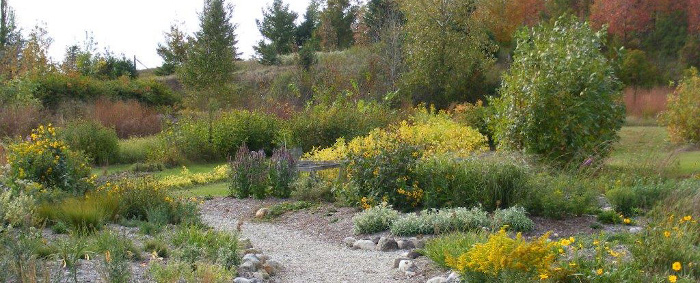
We collect basic website visitor information on this website and store it in cookies. We also utilize Google Analytics to track page view information to assist us in improving our website.
If gardening with native plants is new to you, there's nothing wrong with starting small – adding just a couple native species to your existing yard or garden is a great way to start. Check out our Featured Plants or use the Plant Search to select species native to your area.
Plant taller species in the back of garden beds, with herbaceous plants and groundcovers in the foreground. Vary textures to create visual interest and arrange plantings in odd numbers. Add water features, bird feeders, statues, or other items to add further interest. Consider what the plants you select will look like year-round. Many native species have attractive seed heads that not only provide food for wildlife through the winter months, but also add visual interest to the landscape.
You can learn about native plants and find inspiration in many botanical gardens across Canada. The map below shows the locations and information for many of these. If you know of any more that you'd like to see appear here, please contact us and let us know.
Understand your space before purchasing plants. Assess the garden area and make note of any environmental considerations. This could include recording how many hours of sunlight it gets per day, soil type (loam/sand/silt/clay), and how quickly water drains. Choose plants that are complementary to existing conditions, are sized appropriately for their space, and consider plants that bloom in different seasons.
Many native plants are adapted to poor soil conditions and will require no fertilizer. Instead, leave organic matter like fallen leaves on the planting beds rather than cleaning up your garden in the fall. This will add nutrients to the soil. In fact, it is sometimes advised to avoid adding fertilizer as many native species can flop over in nutrient-rich soils.
Native plants will vary depending on where in Canada you're located. If they’re regionally appropriate, try Bayberry (Myrica sp.) or Eastern White Cedar (Thuja occidentalis) as an alternative to Boxwood or Privet.
There is a great selection of native ornamental grass species in Canada, however it is important to determine which are native to your area. Some Ontario examples include: Little Bluestem (Schizachyrium scoparium), Blue Grama (Bouteloua gracilis), andIndiangrass (Sorghastrum nutans)
There are many small trees native to Canada, although species vary depending on where you are located. Some BC examples include: Vine Maple (Acer circinatum), Western Crabapple (Malus fusca), Saskatoonberry (Amelanchier alnifolia), and Bitter Cherry (Prunus emarginata).
To attract butterflies, species found in the Prairie provinces include Common Milkweed (Asclepias syriaca), Black-eyed Susan (Rudbeckia hirta), Wild Bergamot (Monarda fistulosa), and Canada Goldenrod (Solidago canadensis).
As a Maritimes alternative to the invasive Periwinkle, Goutweed, or English Ivy, try planting Bunchberry (Cornus canadensis), Foamflower (Tiarella cordifolia), Kinnikinnick (Arctostaphylos uva-ursi), or Wild Strawberry (Fragaria virginiana).
Choosing a showy plant which is suitable for the light and soil conditions is important. Some showy Yukon native plants include Blue Columbine (Aquilegia brevistyla), Wooly Arnica (Arnica angustifolia subsp. tomentosa), Fireweed (Chamaenerion angustifolium), and Arctic Lupin (Lupinus arcticus).
Don't take plants from the wild. Many nurseries have retail locations where native plants can be purchased. Seeds and bare-root trees are also often available by mail-order. Our Where to Buy page shows locations across Canada.

Having a wide variety of plants in your garden will help to control pests by minimizing the food source for any one kind of insect. Also, healthy plants will be better able to withstand insect attacks and may even be less attractive to pests. If pests are still an issue, research what the pest is by using a website like Big Bug Hunt and researching methods for controlling that specific pest. We discourage the use of general insecticides as they may kill beneficial insects as well as the pests you would like to target.